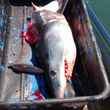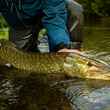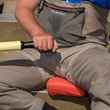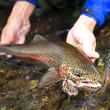During the next 4-6 weeks, fly fishermen in the eastern United States -- from North Carolina and north to Connecticut and New York -- may be able to enjoy something that their western brethren find relatively commonplace, but is rarely experienced on eastern waters: throwing big bugs to voracious trout that aren’t the least bit picky about pattern or presentation.
This year marks the year of the emergence of the Magicicadas, also known as the 17-year or Brood II cicadas. These periodical cicadas, the longest living insects in North America, will emerge in massive numbers throughout the eastern United States with concentrations in some areas approaching 1.5 million insects per acre.
These insects, who have been living underground since 1996, will emerge when the average soil temperature reaches 64 degrees. As their wings harden after emergence, they will take flight to the trees where they will pursue a mate. After mating, these insects will fall to the ground, littering meadows, forest floors and rivers and streams. Unsuspecting trout will quickly key on this bounty of protein, gorging themselves on these readily available bugs.































